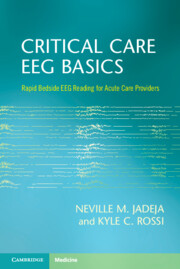Book contents
- Critical Care EEG Basics
- Critical Care EEG Basics
- Copyright page
- Dedication
- Contents
- Foreword
- Preface
- Acknowledgments
- How to Read This Book
- Part I Introduction
- Chapter 1 EEG Basics
- Chapter 2 Indications
- Chapter 3 Real-Time Bedside EEG Reading
- Chapter 4 Recognizing Artifacts and Medication Effects
- Chapter 5 Epileptiform Discharges, Seizures, and Status Epilepticus
- Chapter 6 Rhythmic and Periodic Patterns (RPPs) and the Ictal‐Interictal Continuum (IIC)
- Chapter 7 Post–Cardiac Arrest EEG
- Chapter 8 Quantitative EEG (EEG Trend Analysis)
- Part II Case-Based Approach to Specific Conditions
- Appendix Understanding EEG Reports
- Index
- References
Chapter 4 - Recognizing Artifacts and Medication Effects
from Part I - Introduction
Published online by Cambridge University Press: 22 February 2024
- Critical Care EEG Basics
- Critical Care EEG Basics
- Copyright page
- Dedication
- Contents
- Foreword
- Preface
- Acknowledgments
- How to Read This Book
- Part I Introduction
- Chapter 1 EEG Basics
- Chapter 2 Indications
- Chapter 3 Real-Time Bedside EEG Reading
- Chapter 4 Recognizing Artifacts and Medication Effects
- Chapter 5 Epileptiform Discharges, Seizures, and Status Epilepticus
- Chapter 6 Rhythmic and Periodic Patterns (RPPs) and the Ictal‐Interictal Continuum (IIC)
- Chapter 7 Post–Cardiac Arrest EEG
- Chapter 8 Quantitative EEG (EEG Trend Analysis)
- Part II Case-Based Approach to Specific Conditions
- Appendix Understanding EEG Reports
- Index
- References
Summary
Artifacts are EEG waveforms not generated by the brain. The main purpose of recognizing artifacts is to avoid mistaking them from seizures. They may originate from other body organs (internal) or environmental sources (external). Common internal artifacts include ocular (eye movement), glossokinetic (tongue movement), cardiac (ECG), myogenic (muscle activity), or sweat-sway artifact (skin). Common sources of external artifact include electrodes, ventilators, suction devices, bed percussion, chest compression, and various medical devices. Many commonly used medications are associated with EEG changes. These include excessive alpha and beta activity (e.g., barbiturates and benzodiazepines), theta and delta slowing (antiseizure and psychotropic medications), spike and sharp waves (clozapine), and rhythmic and/or periodic patterns (cefepime). EEG patterns of common intravenous and inhalational anesthetic agents are also described in this chapter.
Keywords
- Type
- Chapter
- Information
- Critical Care EEG BasicsRapid Bedside EEG Reading for Acute Care Providers, pp. 41 - 70Publisher: Cambridge University PressPrint publication year: 2024

